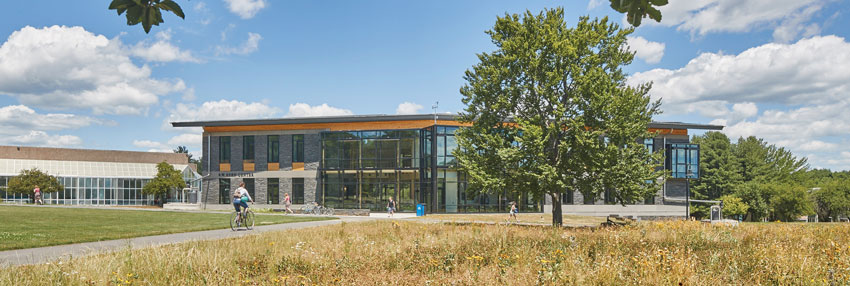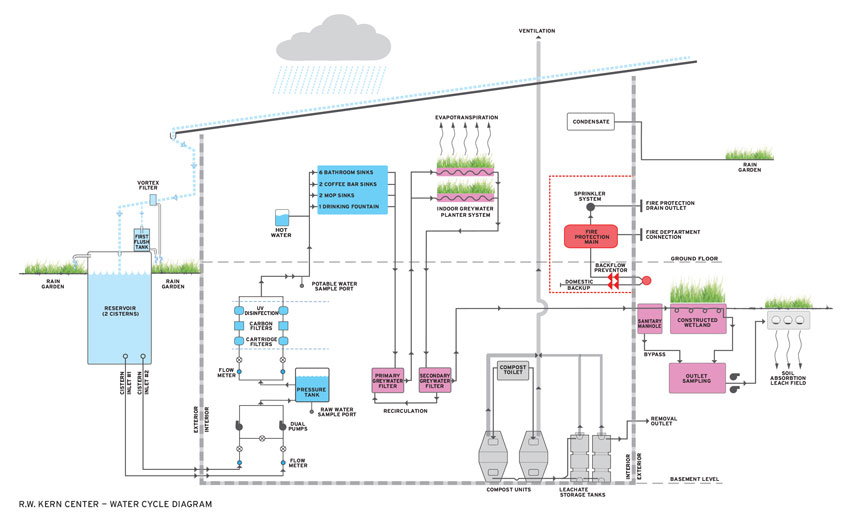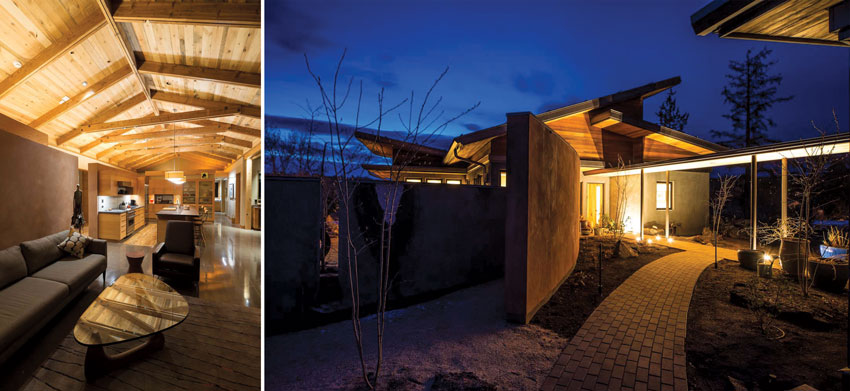Water Conservation
The foundation has made progress toward obtaining the permissions needed to make Bullitt’s rainwater system operational, but one problem has yet to be resolved: the lack of National Sanitation Foundation (NSF) certification of the already installed rooftop photovoltaic (PV) panels as part of the drinking-water-catchment system. Because of its commitment to the concept of rainwater reuse, the client continues to work with the PV manufacturer on a retroactive NSF designation, even though the building has already earned its LBC designation, says Jim Hanford, a Miller Hull principal. The foundation has been “pugnacious” in pursuing net zero water, he says. “It’s pretty impressive.”
Regardless of the outcome of the Bullitt’s efforts to obtain a permit for its rainwater system, the building can claim several water-related innovations, including the world’s first six-story composting system. The building’s overall water consumption is also remarkably low—only 1.1 gallon per square foot over the past 12 months, compared to a 14-gallon-per-square-foot average for Seattle office buildings. But more important, the project has spurred significant regulatory changes. One “triumph,” says Sturgeon, is a set of new city- and state-approved standards for graywater established as a result of the project. These allow the water from the showers, drinking fountains, and sinks to be treated by a constructed wetland on one of the building’s terraces and then infiltrated through a street-level planting strip instead of being drained to the sewer. If widely adopted, the approach could help relieve pressure on the city’s infrastructure, in addition to helping replenish groundwater aquifers.


IMAGES: © ROBERT BENSON (TOP); COURTESY BRUNER/COTT AND BERKSHIRE DESIGN GROUP (BOTTOM)
FINE TUNED
For the R.W. Kern Center at Hampshire College, Bruner/Cott and Berkshire Design closely studied the roof and gutter details to optimize performance of the rainwater-harvesting system.
Some regions seem especially receptive to the LBC and its water-conservation imperative. In Western Massachusetts, there are four completed projects pursuing certification or already certified: Smith College’s off-campus Bechtel Environmental Classroom, in West Whately; the Class of 1966 Environmental Center, at Williams College in Williamstown; and the Hitchcock Center for the Environment and the R.W. Kern Center, both on the campus of Hampshire College in Amherst. Each building benefited from the regulatory successes of the previous project. “By the third one, the permitting process was almost routine,” says Christopher Chamberland, a civil engineer with the Northampton, Massachusetts–based Berkshire Design Group, which has been involved in some aspect of the water systems of all the area’s projects.
The four projects in Western Massachusetts depend on a handful of core strategies: all but Bechtel, which has a well, collect and treat precipitation for their potable-water supply; all purify graywater with devices such as constructed wetlands or rain gardens before reintroducing it into their sites’ natural hydrological system; and all have composting toilets.
In addition to being similar to each other, these projects’ water-conserving features are of course remarkably similar to those deployed at both Bullitt and Brock. But that doesn’t mean that the water systems are interchangeable. They must be tailored to the site and the climate, the program, and, especially, the architecture, says Chamberland. He points to the 17,000-square-foot Kern project, designed by Cambridge, Massachusetts–based Bruner/Cott and dedicated in September. Almost every aspect of the concrete, stone, and timber structure, which serves as a campus social hub and houses administrative offices and classrooms, was the product of intense examination by both the architects and Berkshire Design.
Just one example of the many scrutinized elements are those relating to Kern’s roof, which is a critical part of the rainwater-harvesting system. The two firms studied details such as the optimal slope, the relationship between the overhang and the gutters, and how best to attach screens that help keep leaves and other debris out of the water. “The performance criteria can’t be separated from the architecture,” says Chamberland.
Such functional elements are important in any locale, but in dry climates, they take on heightened relevance. This was the case for Desert Rain, a recently LBC-certified single-family residential project in Bend, Oregon, designed by local firm Tozer Design. As the name of the compound of five wood-framed buildings with butterfly roofs implies, the project depends on precipitation for its potable supply and was one of the first in Oregon to take advantage of new state guidelines for rainwater harvesting.

PHOTOGRAPHY: © ROSS CHANDLER/CHANDLER PHOTOGRAPHY
WATER MISER
Tozer Design’s residential project Desert Rain in Bend, Oregon, captures precipi-tation from its butterfly roofs for all potable uses. It is designed around a daily water budget of 42 gallons per occupant.
Since Bend averages only 12 inches of precipitation per year, and in some years gets as little as 7, the Desert Rain team needed to capture every drop—even with a miserly water budget of 42 gallons per occupant per day, says Morgan Brown, president of Whole Water Systems, the firm responsible for design of the project’s water technology. (A typical budget is more than twice that, he says.) One innovation was the substitution of a device known as a first flush diverter, or FFD, which disposes of the initial runoff from a roof surface and any contaminants that come with it. Instead, Brown devised ground-level gravel filters positioned under each roof downspout. These remove unwanted debris while capturing up to 15 percent more water, he says.
In addition to rainwater harvesting, Desert Rain also took advantage of a rule for graywater reuse issued while the project was already under way. The system directs the water from sinks, showers, and washing machines through a constructed wetland for remediation before it is used for irrigation. Partly because of the newness of all the regulations and officials’ unfamiliarity with the proposed systems, the project took almost seven years to complete. “Normally we could have designed something like this in a few weeks,” says Brown. But he’s pleased to have been part of a project that broke new ground and takes its cues from nature’s water cycle, he says. “It’s the ultimate example of biomimicry.”








